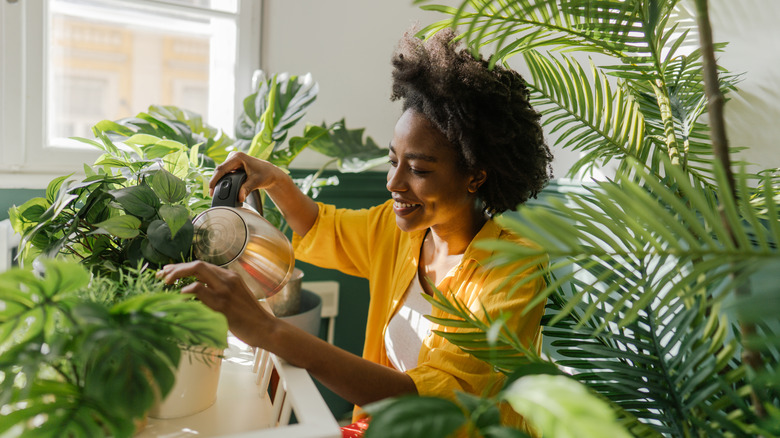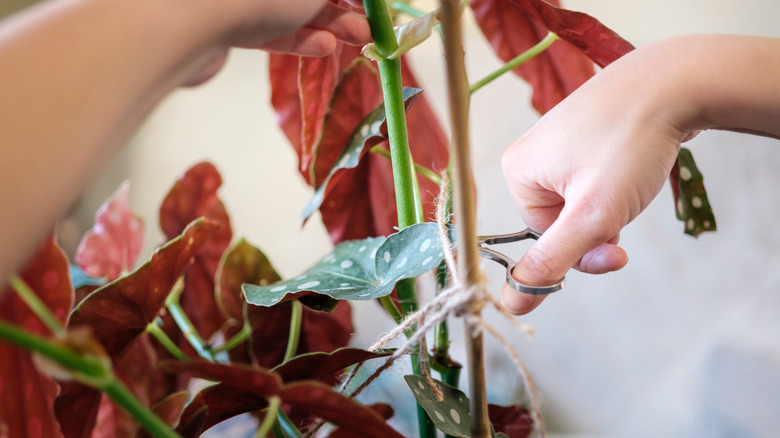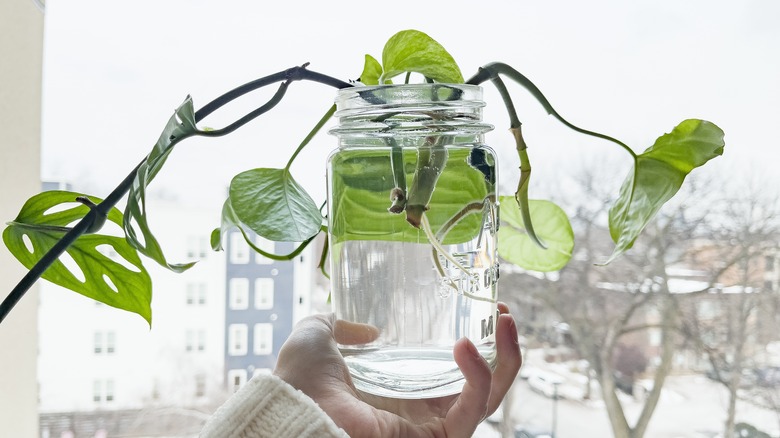Our Master Gardener's Top Tips For Making Houseplants Look Fuller And Lush
When you purchase a new houseplant, the first thing you look for is full, lush growth as an indicator of a healthy plant. What you find at your local garden center has been grown in ideal conditions with the perfect amount of light, water, and fertilizer. It's often a different story when they get to a big box garden center where, after a few weeks of less-than-ideal conditions, they may end up on a clearance rack. I like to call these rescue plants, like the ferns I bought for the tiny terrariums I made out of antique jars. Whether you're trying to restore rescued plants to their previous glory or your existing houseplants are looking a little spindly, pinching might be the solution to your puny plant problems.
Not all houseplants will benefit from pinching or trimming back the tops. Those that grow individual leaves from the crown, or soil level, should only have damaged or yellowing leaves removed. This includes common plants like peace lilies and palms. Conversely, many houseplants that grow as vines or stems may benefit from pinching back to make the top produce new leaves, giving the plant a fuller look. For many of those options, you can root the cuttings and add them to the planter to fill out the base.
Pinching plants for fuller foliage
I'm using the term "pinch" loosely, since you can use your fingers, but trimming with small pruning shears is also an option. In fact, if you plan to root your cuttings, a sharp slice will do less damage to the plant tissue. When I'm pruning one of my many easy to grow begonias, I take a cutting just below where they start to get spindly from being indoors all winter. For many varieties, like polka dot and angel wing, this is where they start to produce new leaves, filling out nicely in the next few months. While there's no single rule that applies to all plants, this is the most common result among most houseplants that benefit from this kind of pruning. Before you start pinching or cutting, it's a good idea to research the best way to prune your specific type of houseplant so you don't do permanent damage.
Since I can't tell you to exactly what height or spacing different types of plants should be trimmed, it's best to keep the rule of thirds in mind. Whether you're pruning trees, shrubs, or houseplants, never remove more than one-third. So when you're looking at your plants, you can pinch one-third off the top to encourage growth. If the plant has gotten severely leggy, trim off a third in early spring, and again in late summer, to encourage extra new top growth before they go semi-dormant in the winter.
Simple snips for voluptuous vines
Many stems and vines can be rooted in water. In fact, this is the best way to propagate a heartleaf philodendron. Other vining plants like pothos, spiderwort, and Adanson's monstera benefit from some pruning to help fill out the planter. Vines tend to get spindly in low light conditions, so adding extra plants to the soil helps bulk them up.
If you were to take one of those full planters from the garden center and remove all the greenery from the soil, you'd likely find multiple plants in one container. You can duplicate this at home by trimming a 4 to 6 inch section of a vine, just below a node — the section that will produce a root. Ideally, each cutting would have at least two nodes and a couple leaves. Remember not to remove more than one-third of the overall plant.
Place those cuttings in water, changing it every few days so pathogens don't grow. Once the roots are over 1 inch long, you can carefully add your cuttings to your existing planter. If your plant has been in that soil for more than a year or so, it would probably benefit from some fresh nutrients. Add high-quality garden soil in a clean planter with good drainage, and combine your freshly rooted cuttings with your existing plant for a nice full look that will only get better as it grows.


